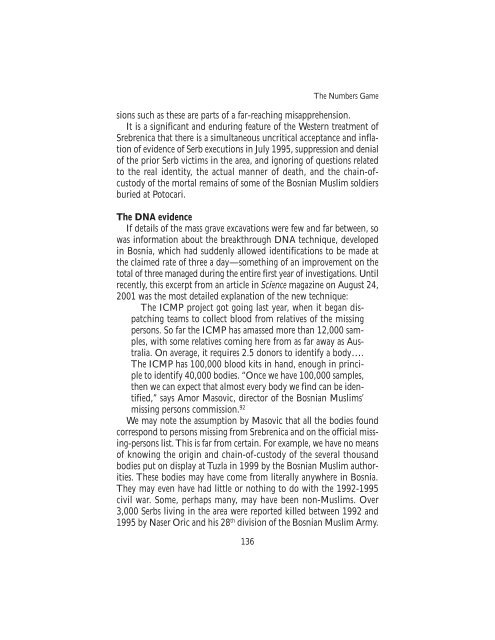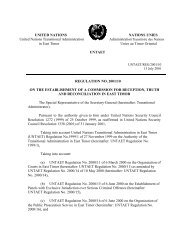The Srebrenica Massacre - Nova Srpska Politicka Misao
The Srebrenica Massacre - Nova Srpska Politicka Misao
The Srebrenica Massacre - Nova Srpska Politicka Misao
You also want an ePaper? Increase the reach of your titles
YUMPU automatically turns print PDFs into web optimized ePapers that Google loves.
<strong>The</strong> Numbers Game<br />
sions such as these are parts of a far-reaching misapprehension.<br />
It is a significant and enduring feature of the Western treatment of<br />
<strong>Srebrenica</strong> that there is a simultaneous uncritical acceptance and inflation<br />
of evidence of Serb executions in July 1995, suppression and denial<br />
of the prior Serb victims in the area, and ignoring of questions related<br />
to the real identity, the actual manner of death, and the chain-ofcustody<br />
of the mortal remains of some of the Bosnian Muslim soldiers<br />
buried at Potocari.<br />
<strong>The</strong> DNA evidence<br />
If details of the mass grave excavations were few and far between, so<br />
was information about the breakthrough DNA technique, developed<br />
in Bosnia, which had suddenly allowed identifications to be made at<br />
the claimed rate of three a day—something of an improvement on the<br />
total of three managed during the entire first year of investigations. Until<br />
recently, this excerpt from an article in Science magazine on August 24,<br />
2001 was the most detailed explanation of the new technique:<br />
<strong>The</strong> ICMP project got going last year, when it began dispatching<br />
teams to collect blood from relatives of the missing<br />
persons. So far the ICMP has amassed more than 12,000 samples,<br />
with some relatives coming here from as far away as Australia.<br />
On average, it requires 2.5 donors to identify a body….<br />
<strong>The</strong> ICMP has 100,000 blood kits in hand, enough in principle<br />
to identify 40,000 bodies. “Once we have 100,000 samples,<br />
then we can expect that almost every body we find can be identified,”<br />
says Amor Masovic, director of the Bosnian Muslims’<br />
missing persons commission. 92<br />
We may note the assumption by Masovic that all the bodies found<br />
correspond to persons missing from <strong>Srebrenica</strong> and on the official missing-persons<br />
list. This is far from certain. For example, we have no means<br />
of knowing the origin and chain-of-custody of the several thousand<br />
bodies put on display at Tuzla in 1999 by the Bosnian Muslim authorities.<br />
<strong>The</strong>se bodies may have come from literally anywhere in Bosnia.<br />
<strong>The</strong>y may even have had little or nothing to do with the 1992-1995<br />
civil war. Some, perhaps many, may have been non-Muslims. Over<br />
3,000 Serbs living in the area were reported killed between 1992 and<br />
1995 by Naser Oric and his 28 th division of the Bosnian Muslim Army.<br />
136



